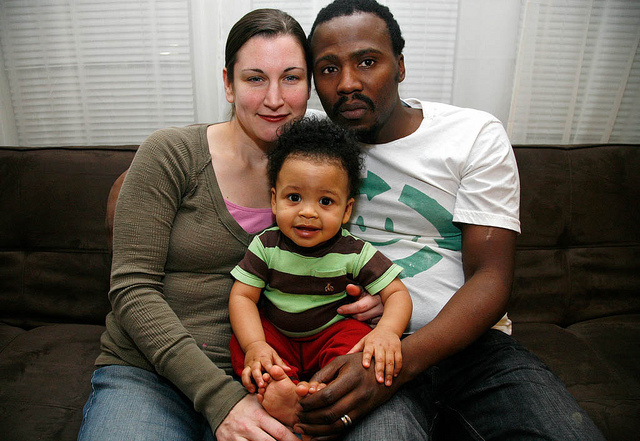9.2: Intercultural Romantic Relationships
- Page ID
- 58546
\( \newcommand{\vecs}[1]{\overset { \scriptstyle \rightharpoonup} {\mathbf{#1}} } \)
\( \newcommand{\vecd}[1]{\overset{-\!-\!\rightharpoonup}{\vphantom{a}\smash {#1}}} \)
\( \newcommand{\id}{\mathrm{id}}\) \( \newcommand{\Span}{\mathrm{span}}\)
( \newcommand{\kernel}{\mathrm{null}\,}\) \( \newcommand{\range}{\mathrm{range}\,}\)
\( \newcommand{\RealPart}{\mathrm{Re}}\) \( \newcommand{\ImaginaryPart}{\mathrm{Im}}\)
\( \newcommand{\Argument}{\mathrm{Arg}}\) \( \newcommand{\norm}[1]{\| #1 \|}\)
\( \newcommand{\inner}[2]{\langle #1, #2 \rangle}\)
\( \newcommand{\Span}{\mathrm{span}}\)
\( \newcommand{\id}{\mathrm{id}}\)
\( \newcommand{\Span}{\mathrm{span}}\)
\( \newcommand{\kernel}{\mathrm{null}\,}\)
\( \newcommand{\range}{\mathrm{range}\,}\)
\( \newcommand{\RealPart}{\mathrm{Re}}\)
\( \newcommand{\ImaginaryPart}{\mathrm{Im}}\)
\( \newcommand{\Argument}{\mathrm{Arg}}\)
\( \newcommand{\norm}[1]{\| #1 \|}\)
\( \newcommand{\inner}[2]{\langle #1, #2 \rangle}\)
\( \newcommand{\Span}{\mathrm{span}}\) \( \newcommand{\AA}{\unicode[.8,0]{x212B}}\)
\( \newcommand{\vectorA}[1]{\vec{#1}} % arrow\)
\( \newcommand{\vectorAt}[1]{\vec{\text{#1}}} % arrow\)
\( \newcommand{\vectorB}[1]{\overset { \scriptstyle \rightharpoonup} {\mathbf{#1}} } \)
\( \newcommand{\vectorC}[1]{\textbf{#1}} \)
\( \newcommand{\vectorD}[1]{\overrightarrow{#1}} \)
\( \newcommand{\vectorDt}[1]{\overrightarrow{\text{#1}}} \)
\( \newcommand{\vectE}[1]{\overset{-\!-\!\rightharpoonup}{\vphantom{a}\smash{\mathbf {#1}}}} \)
\( \newcommand{\vecs}[1]{\overset { \scriptstyle \rightharpoonup} {\mathbf{#1}} } \)
\( \newcommand{\vecd}[1]{\overset{-\!-\!\rightharpoonup}{\vphantom{a}\smash {#1}}} \)
\(\newcommand{\avec}{\mathbf a}\) \(\newcommand{\bvec}{\mathbf b}\) \(\newcommand{\cvec}{\mathbf c}\) \(\newcommand{\dvec}{\mathbf d}\) \(\newcommand{\dtil}{\widetilde{\mathbf d}}\) \(\newcommand{\evec}{\mathbf e}\) \(\newcommand{\fvec}{\mathbf f}\) \(\newcommand{\nvec}{\mathbf n}\) \(\newcommand{\pvec}{\mathbf p}\) \(\newcommand{\qvec}{\mathbf q}\) \(\newcommand{\svec}{\mathbf s}\) \(\newcommand{\tvec}{\mathbf t}\) \(\newcommand{\uvec}{\mathbf u}\) \(\newcommand{\vvec}{\mathbf v}\) \(\newcommand{\wvec}{\mathbf w}\) \(\newcommand{\xvec}{\mathbf x}\) \(\newcommand{\yvec}{\mathbf y}\) \(\newcommand{\zvec}{\mathbf z}\) \(\newcommand{\rvec}{\mathbf r}\) \(\newcommand{\mvec}{\mathbf m}\) \(\newcommand{\zerovec}{\mathbf 0}\) \(\newcommand{\onevec}{\mathbf 1}\) \(\newcommand{\real}{\mathbb R}\) \(\newcommand{\twovec}[2]{\left[\begin{array}{r}#1 \\ #2 \end{array}\right]}\) \(\newcommand{\ctwovec}[2]{\left[\begin{array}{c}#1 \\ #2 \end{array}\right]}\) \(\newcommand{\threevec}[3]{\left[\begin{array}{r}#1 \\ #2 \\ #3 \end{array}\right]}\) \(\newcommand{\cthreevec}[3]{\left[\begin{array}{c}#1 \\ #2 \\ #3 \end{array}\right]}\) \(\newcommand{\fourvec}[4]{\left[\begin{array}{r}#1 \\ #2 \\ #3 \\ #4 \end{array}\right]}\) \(\newcommand{\cfourvec}[4]{\left[\begin{array}{c}#1 \\ #2 \\ #3 \\ #4 \end{array}\right]}\) \(\newcommand{\fivevec}[5]{\left[\begin{array}{r}#1 \\ #2 \\ #3 \\ #4 \\ #5 \\ \end{array}\right]}\) \(\newcommand{\cfivevec}[5]{\left[\begin{array}{c}#1 \\ #2 \\ #3 \\ #4 \\ #5 \\ \end{array}\right]}\) \(\newcommand{\mattwo}[4]{\left[\begin{array}{rr}#1 \amp #2 \\ #3 \amp #4 \\ \end{array}\right]}\) \(\newcommand{\laspan}[1]{\text{Span}\{#1\}}\) \(\newcommand{\bcal}{\cal B}\) \(\newcommand{\ccal}{\cal C}\) \(\newcommand{\scal}{\cal S}\) \(\newcommand{\wcal}{\cal W}\) \(\newcommand{\ecal}{\cal E}\) \(\newcommand{\coords}[2]{\left\{#1\right\}_{#2}}\) \(\newcommand{\gray}[1]{\color{gray}{#1}}\) \(\newcommand{\lgray}[1]{\color{lightgray}{#1}}\) \(\newcommand{\rank}{\operatorname{rank}}\) \(\newcommand{\row}{\text{Row}}\) \(\newcommand{\col}{\text{Col}}\) \(\renewcommand{\row}{\text{Row}}\) \(\newcommand{\nul}{\text{Nul}}\) \(\newcommand{\var}{\text{Var}}\) \(\newcommand{\corr}{\text{corr}}\) \(\newcommand{\len}[1]{\left|#1\right|}\) \(\newcommand{\bbar}{\overline{\bvec}}\) \(\newcommand{\bhat}{\widehat{\bvec}}\) \(\newcommand{\bperp}{\bvec^\perp}\) \(\newcommand{\xhat}{\widehat{\xvec}}\) \(\newcommand{\vhat}{\widehat{\vvec}}\) \(\newcommand{\uhat}{\widehat{\uvec}}\) \(\newcommand{\what}{\widehat{\wvec}}\) \(\newcommand{\Sighat}{\widehat{\Sigma}}\) \(\newcommand{\lt}{<}\) \(\newcommand{\gt}{>}\) \(\newcommand{\amp}{&}\) \(\definecolor{fillinmathshade}{gray}{0.9}\)Intercultural Romantic Relationships
As with intercultural friendships, there are also similarities and differences between how romantic relationships are perceived in different cultures. When two various cultures come together, there may be significant challenges they have to face, but it is important to remember that like any relationship, intercultural romantic relationships are all different. In general, romantic intercultural relationships are “voluntary,” and most cultures stress the importance of openness, mutual involvement, shared nonverbal meanings, and relationship assessment (Martin & Nakayama, 2014).
Facilitating Factors
Every day you meet and interact with new people while going about your daily life, yet few of these people will make a lasting impression. Have you ever wondered what draws you to these special few? It is not a mystery. The factors include physical attractiveness, similarity, complementarity, proximity, reciprocal liking, and resources (Aron et al., 2008). It’s not a secret that many people feel drawn those that they perceive as physically attractive, but we also need to remember that the idea of attractiveness is not always the most stunningly beautiful or stunningly handsome person in the area. Attractiveness can also be what is familiar to us. Most of us do find physical beauty attractive to us, but we tend to form long-term romantic relationships with people we judge as similar to ourselves in physical attractiveness (Feingold, 1988; White, 1980).
Undoubtedly you’ve heard the common saying, “birds of a feather flock together.” This is the same for relationships. Scientific evidence suggests that we are attracted to those we perceive as similar to ourselves (Miller, 2014). One explanation for this is that people we view as similar to ourselves are less likely to cause uncertainty. They seem easier to predict, and we feel more comfortable with them (Berger & Calabrese, 1975). Similarity is more than physical attractiveness though, it means sharing personalities, values, and preferences (Markey & Markey, 2007).
Another common saying that you have probably heard is that “opposites attract.” Complementarity has been debated for a long time, and so far the research is inconclusive. Based on the 1950s research of sociologist Robert Winch, we would say that we are naturally attracted to people who are different from ourselves, and therefore, somewhat exciting. It was believed to be a natural quest for completion. Unfortunately, more current research from Markey & Markey (2007) found the opposite. What is not in question is when it comes to work colleagues and friends. On the job or with friends, we are not particularly interested in dealing with people who are unlike ourselves. Generally, we are most interested in dealing with people who are like ourselves and don’t display a lot of patience or motivation for dealing with our opposites (Ickes, 1999).
The simple fact of proximity, or often being around each other, exerts far more impact on relationships than generally acknowledged. The idea is that you are more likely to feel attracted to people with whom you have frequent contact with and are less attracted to those with whom you rarely interact. Another often overlooked determinant of attraction is reciprocal liking (Aron et al., 2008). The idea is quite simple, we tend to be attracted to people who are attracted to us. Studies examining stories about “falling in love” have found that reciprocal liking is the most commonly mentioned factor leading to love (Riela, Rodriguez, Aron, Xu, and Acevedo, 2010). And lastly, the final attraction foundation is called resources. Resources include such qualities as sense of humor, intelligence, kindness, supportiveness, and more (Felmlee et al., 2010). Social exchange theory proposed that you will feel drawn to people that you see as offering benefits (things that you want) with few associated costs (things demanded from you in return) (Kelley & Thibaut, 1978). In other words, you’re attracted to people who can give you what you want and who offer better rewards than others.
Individualism and Collectivism in Romantic Relationships
Individualism and collectivism play a role in romantic relationships as well. In individualistic cultures such as the United States, togetherness is important as long as it doesn’t interfere too much with one’s individual autonomy. Physical attraction, passion, and love are often initiators of romantic relationships in individualistic cultures. Being open, talking things out, and retaining a sense of self are maintenance strategies.
Collectivistic cultures often value acceptance and “fitting in” as the most important values for romantic partners. Family approval can make or break a romantic relationship. Family members are expected to align with, and support, the dominant values, beliefs, and behavioral expectations of the family hierarchy. Individual happiness is important, but thought only to be fully realized within the family system.
Conflict in Intercultural Relationships
Intercultural marriages and couplings are growing at an increasing rate. What once might have seemed unusual or exotic is becoming more accepted and common place. Finding an intercultural love relationship might be getting easier, but negotiating through the unique challenges inherent to these relationships can still be difficult. Romano (2008) found four distinct conflict styles that reflect how intercultural couples negotiate their way through the differences. The submission style is the most common and involves one partner abdicating power to the other partner’s culture or cultural preferences. Sometimes the submission is only seen as a display for the public, whereas the relationship may be more balanced in private. Even though it is the most popular style, this approach rarely works because submission often involves denying certain aspect’s of one’s own culture. Although the compromise style might seem to be the most desirable, it really means that both people must sacrifice some aspect of their life. Each partner gives up some culturally bound habit or value to accommodate the other. Game theorists would call this a lose-lose or no-win situation.
Some couples will try the obliteration style. In this case, both partners try to erase or obliterate their original cultures, and create a new “culture” with new beliefs, values, and behaviors. This can be extremely difficult and create problems with other family members, but more likely if the couple lives in country that is “home” to neither of them. The ideal solution is the consensus style. As it is based on negotiation and mutual agreement, neither person has to assume that they must abandon their own culture. This style is related to compromise because of the give-and-take, but it is not a trade-off. Game theorists call this a win-win proposition.
In a survey on intercultural marriages (Prokopchak, 1994), couples were asked to respond about the positives and negatives of intercultural marriage. This survey resulted in four cautions to be considered during intercultural conflict. First, know each other’s culture. Don’t think that all families and all cultures operate in a certain way. Second, be accountable. There is a tendency not to listen to others. Weigh their concerns. Third, know what both cultures value. There is a tendency to value things, but people should be of primary concern. And last, identify adaptation versus core value changes. Be aware of the differences between behavior modification or adaptation and core value changes.
Romantic relationships are influenced by society and culture, and still today some people face discrimination based on who they love. Specifically, sexual orientation and race affect societal views of romantic relationships.
Gay & Lesbian Relationships
There has been much more research done on heterosexual or cisgender intercultural friendships and romantic relationships than gay or same-sex intercultural relationships. Although there are many similarities between gay and cisgender relationships, Martin and Nakayama (2014) believe that such relationships differ in at least four areas. These areas include the importance of close friendships, conflict management, intimacy, and the role of sexuality. Close relationships and friendships might be more important to gays and lesbians who often rely on these ties in the face of social stigma, family ostracism, and discrimination. Researchers Gottman and Levenson (2004) have found some positive differences in the area of conflict management for gay and lesbian couples. Gay relationships often start with sexual attraction, but often persist after sexual involvement has ceased (Martin & Nakayama, 2014).
Although homosexuality has existed throughout human history, cultures can have vast differences in how they support, accept, and categorize attraction and sexual relations between persons of the same gender. Two-Spirit, a pre-contact pan-Indian term, has been adopted by some modern indigenous North Americans to describe gender-variant individuals in their communities (Medicine, 2002; Enos, 2017). Not all tribes or nations have rigid gender roles, but among those that do, some consider there to be at least four genders: feminine woman, masculine woman, feminine man, and masculine man (Estrada, 2010). Many East and Southeast Asian languages, including Chinese, do not contain grammatical gender, and also have histories of cultural tolerance.
Although the United States, as a whole, is becoming more accepting of gay and lesbian relationships, there is still a climate of prejudice and discrimination that individuals in same-gender romantic relationships must face. Despite some physical and virtual meeting places for gay and lesbian people, there are challenges for meeting and starting romantic relationships that are not experienced for most heterosexual people (Peplau & Spalding, 2000).
As we’ve already discussed, romantic relationships are likely to begin due to merely being exposed to another person at work, through a friend, and so on. But some gay and lesbian people may feel pressured into or just feel more comfortable not disclosing or displaying their sexual orientation at work or perhaps even to some family and friends, which closes off important social networks through which most romantic relationships begin. This pressure to refrain from disclosing one’s gay or lesbian sexual orientation is not unfounded, as discrimination on the basis of sexual orientation is still widespread. Gay and lesbian couples do not have the same legal and societal resources to manage their relationships as heterosexual couples; for example, it is more difficult for a gay or lesbian couple to jointly own property or share custody of children than heterosexual couples, and there is little public funding for relationship counseling or couples therapy for gay and lesbian couples.

Despite these challenges, relationships between gay and lesbian people are similar in other ways to those between heterosexuals. Gay, lesbian, and heterosexual people seek similar qualities in a potential mate, and once relationships are established, all these groups experience similar degrees of relational satisfaction (Peplau & Spalding, 2000). Despite the myth that one person plays the man and one plays the woman in a relationship, gay and lesbian partners do not have set preferences in terms of gender role. In fact, research shows that while women in heterosexual relationships tend to do more of the housework, gay and lesbian couples were more likely to divide tasks so that each person has an equal share of responsibility (Peplau & Spalding, 2000). A gay or lesbian couple doesn’t necessarily constitute an intercultural relationship, but as we have already discussed, sexuality is an important part of an individual’s identity and connects to larger social and cultural systems. Keeping in mind that identity and culture are complex, we can see that gay and lesbian relationships can also be intercultural if the partners are of different racial or ethnic backgrounds.
Interracial Relationships
While interracial relationships have occurred throughout history, there have been more historical taboos in the United States regarding relationships between African Americans and white people than other racial groups. Antimiscegenation laws were common in states and made it illegal for people of different racial/ethnic groups to marry. It wasn’t until 1967 that the Supreme Court ruled in the case of Loving versus Virginia, declaring these laws to be unconstitutional (Pratt, 1995). It wasn’t until 1998 and 2000, however, that South Carolina and Alabama removed such language from their state constitutions (Lovingday.org, 2011). The organization and website lovingday.org commemorates the landmark case and works to end racial prejudice through education.

Even after these changes, there were more Asian-white and Latinx-white relationships than there were African American–white relationships (Gaines Jr. & Brennan, 2011). Having already discussed the importance of similarity in attraction to mates, it’s important to note that partners in an interracial relationship, although culturally different, tend to be similar in occupation and income. This can likely be explained by the situational influences on our relationship formation we discussed earlier—namely, that work tends to be a starting ground for many of our relationships, and we usually work with people who have similar backgrounds to us.
There has been much research on interracial couples that counters the popular notion that partners may be less satisfied in their relationships due to cultural differences. In fact, relational satisfaction isn’t significantly different for interracial partners, although the challenges they may face in finding acceptance from other people could lead to stressors that are not as strong for intracultural partners (Gaines Jr. & Brennan, 2011). Although partners in interracial relationships certainly face challenges, there are positives. For example, some mention that they’ve experienced personal growth by learning about their partner’s cultural background, which helps them gain alternative perspectives. Specifically, white people in interracial relationships have cited an awareness of and empathy for racism that still exists, which they may not have been aware of before (Gaines Jr. & Liu, 2000).
Contributors and Attributions
- Communication in the Real World: An Introduction to Communication Studies, by No Attribution- Anonymous by request. Provided by LibreTexts. License: CC-BY-NC-SA
- Intercultural Communication for the Community College, by Karen Krumrey-Fulks. Provided by LibreTexts. License: CC-BY-NC-SA


